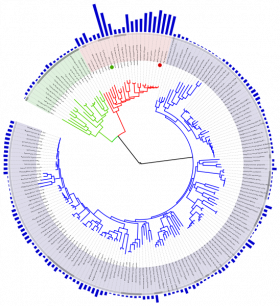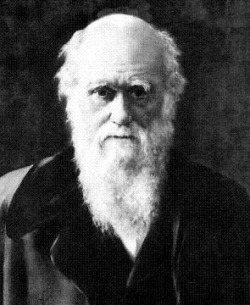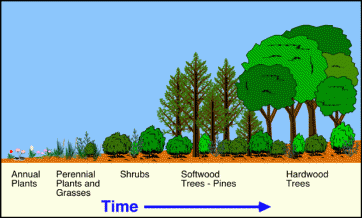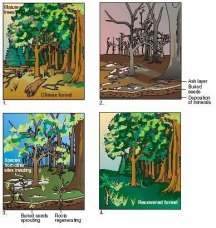Evolution

"Evolutionists have been very clear about this distinction of fact and theory from the very beginning, if only because we have always acknowledged how far we are from completely understanding the mechanisms (theory) by which evolution (fact) occurred. Darwin continually emphasized the difference between his two great and separate accomplishments: establishing the fact of evolution, and proposing a theory--natural selection--to explain the mechanism of evolution."
- Stephen J. Gould, " Evolution as Fact and Theory"; Discover, May 1981
Evolution is a theory. It is also a fact. And facts and theories are different things, but they are also the same. Literally, facts are the world's data, and theories are structures of ideas that explain and interpret facts. Facts don't go away when scientists debate theories to explain them. In science "fact" can only mean "confirmed information with extreme evidence to support it as such."
Darwin's Theory of Evolution states that all life is related and has come from a common ancestor. Darwin's general theory states that complex creatures evolve from more simplistic ancestors naturally over time. While Darwin's Theory of Evolution is relatively young, the 'theory' itself is as old as antiquity. Ancient Greek philosophers such as showed the evolutionary descent of man from animal, Charles Darwin simply brought something new to the old philosophy -"natural selection." Natural selection acts to preserve and accumulate minor genetic mutations. For example, suppose a member of a species it grew wings and learned to fly. Its offspring would inherit that advantage and pass it on to their offspring. The disadvantaged members of the same species would gradually die out, leaving only the superior members of the species. Natural selection is the preservation of a functional advantage that enables a species to compete better in the wild.
- Stephen J. Gould, " Evolution as Fact and Theory"; Discover, May 1981
Evolution is a theory. It is also a fact. And facts and theories are different things, but they are also the same. Literally, facts are the world's data, and theories are structures of ideas that explain and interpret facts. Facts don't go away when scientists debate theories to explain them. In science "fact" can only mean "confirmed information with extreme evidence to support it as such."
Darwin's Theory of Evolution states that all life is related and has come from a common ancestor. Darwin's general theory states that complex creatures evolve from more simplistic ancestors naturally over time. While Darwin's Theory of Evolution is relatively young, the 'theory' itself is as old as antiquity. Ancient Greek philosophers such as showed the evolutionary descent of man from animal, Charles Darwin simply brought something new to the old philosophy -"natural selection." Natural selection acts to preserve and accumulate minor genetic mutations. For example, suppose a member of a species it grew wings and learned to fly. Its offspring would inherit that advantage and pass it on to their offspring. The disadvantaged members of the same species would gradually die out, leaving only the superior members of the species. Natural selection is the preservation of a functional advantage that enables a species to compete better in the wild.
Ecological Succession
There are two types of ecological succession, primary and secondary succession. Primary succession occurs depending upon the amounts of moisture, temperature, and wind. Simple plants such as lichen, which were the first organisms to live on bare rock and moss, begin to sprout because they can grow off of rocks from the cervices where water and dissolved minerals are located. As these simple plants die they create soil which is more complex so plants such as grass and herbs may grow. Once these complex plants die they create another layer of solid which allows even more complex plants to grow. In the final stage or, the climax community, tall trees grow.
Secondary succession occurs on a previously colonized habitat however the habitat was disrupted by a naturally occurring disaster such as a forest fire or a flood. This process usually occurs quicker than primary succession. It’s faster because there are already seed in the soil, root systems are undisrupted, stumps and other plant parts from preexisting plants can rapidly regenerate, and the soil is fertile which is good for growth and colonization. This process is allowed to skip the lichen stage because the soil is already fertile.
Secondary succession occurs on a previously colonized habitat however the habitat was disrupted by a naturally occurring disaster such as a forest fire or a flood. This process usually occurs quicker than primary succession. It’s faster because there are already seed in the soil, root systems are undisrupted, stumps and other plant parts from preexisting plants can rapidly regenerate, and the soil is fertile which is good for growth and colonization. This process is allowed to skip the lichen stage because the soil is already fertile.
Big Bang Theory

http://quarknet.fnal.gov/eeu/bigbang.jpg
The Big Bang Theory was the beginning of the universe. It’s said that all matter was confined in an infinitely small point in space and it just exploded everywhere in every direction. There are three main pieces of evidence to support the Big Bang Theory.
The first piece of evidence is that Edwin Hubble discovered evidence of an expanding universe. The Dobbler Shift explains how light in outer space will emit certain colors if it is moving away or towards you. Colors are expressed in wave lengths. Red light has the longest wavelength and violet/ blue have the shortest wavelength. If something that emits light is moving towards Earth, the wavelength will compress and the color becomes blue. This is called the Blue Shift. If something that emits light is moving away from earth the wavelength gets longer and the color becomes redder. This is called the Red Shift. Hubble discovered that the light we receive on Earth from anything emitting light is Red Shifted. Therefore, everything in the universe is moving away from us, so the universe must be expanding.
The second piece of evidence is that Hydrogen and Helium are the most abundant elements in our universe. Scientists discovered that three minutes after the Big Bang the temperature of the universe was just right to form 75% hydrogen and 25% helium. Today, precise measurements prove that those are the exact amounts of hydrogen and helium found in our universe today.
The third piece of evidence is background cosmic radiation. This is the left over energy from the Big Bang and is found everywhere in our universe. It measures as 2-3 Kelvin. Two workers for AT&T were working on a satellite dish when they discovered something was blocking their signal. They found that it was background cosmic radiation. The Big Bang Theory relates to Genesis because this is the theory that we use to prove scientifically how the universe was created. Genesis is about the beginning and so is the Big Bang Theory
The first piece of evidence is that Edwin Hubble discovered evidence of an expanding universe. The Dobbler Shift explains how light in outer space will emit certain colors if it is moving away or towards you. Colors are expressed in wave lengths. Red light has the longest wavelength and violet/ blue have the shortest wavelength. If something that emits light is moving towards Earth, the wavelength will compress and the color becomes blue. This is called the Blue Shift. If something that emits light is moving away from earth the wavelength gets longer and the color becomes redder. This is called the Red Shift. Hubble discovered that the light we receive on Earth from anything emitting light is Red Shifted. Therefore, everything in the universe is moving away from us, so the universe must be expanding.
The second piece of evidence is that Hydrogen and Helium are the most abundant elements in our universe. Scientists discovered that three minutes after the Big Bang the temperature of the universe was just right to form 75% hydrogen and 25% helium. Today, precise measurements prove that those are the exact amounts of hydrogen and helium found in our universe today.
The third piece of evidence is background cosmic radiation. This is the left over energy from the Big Bang and is found everywhere in our universe. It measures as 2-3 Kelvin. Two workers for AT&T were working on a satellite dish when they discovered something was blocking their signal. They found that it was background cosmic radiation. The Big Bang Theory relates to Genesis because this is the theory that we use to prove scientifically how the universe was created. Genesis is about the beginning and so is the Big Bang Theory
Micro-Organisms
"Life could have started up from the small molecules that nature provided," - Robert Shapiro
Three billion years ago, the first living organisms appeared on earth. They were single-celled creatures, and they were also heterotrophic anaerobes. (When a creature is a heterotroph, it means that they cannot produce their own food, and when an organism is anaerobic it means that they can survive without any supply of oxygen.) Hence, these tiny little creatures ate whatever was available in the oceans. Then after another billion years, these single celled creatures began to multiply themselves into multi-cellular organisms. Some of these organisms gained a trait which allowed them to produce their own food. These creatures are known as Stromatolites. Stromatolites are able to photosynthesize their own food, and as a product, they create oxygen as well. These organisms survived in rather unusual places such as acidic water. Today’s archea bacteria are very similar to the first organisms.






